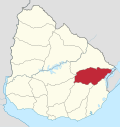|
Treinta y Tres Department
Treinta y Tres (Spanish pronunciation: [ˈtɾejntaj ˈtɾes]) is a department of Uruguay. Its capital is Treinta y Tres. It is located in the east of the country, bordering the departments of Cerro Largo to the north, Durazno and Florida to the west, Lavalleja and Rocha to the south, while to its east is the lake Laguna Merín separating it from the southernmost end of Brazil. With a total population of 50,504, it is the second-least populated department in Uruguay (ahead of Flores) and the third-least densely populated, behind Durazno and Flores. HistoryThe area now known as the Treinta y Tres Department has been long populated by Indigenous peoples as evidenced by Cerritos de Indios. When the First Constitution of Uruguay was signed in 1830, the territory of this department was mostly part of Cerro Largo, one of the nine original departments of the Republic. In 1853 the pueblo (village) of Treinta y Tres was created in its south. It was named after the thirty three honoured patriots who fought for and secured the Independence of the old Provincia Oriental, which became Uruguay. A permanent service of transport by horse-drawn carts between this pueblo and Montevideo was first established in 1866.[1] On 18 September 1884 and by the Act of Ley No 1.754, the department of Treinta y Tres was created out of parts of the departments of Cerro Largo and Minas (the actual Lavalleja Department). GeographyThe terain of Treinta y Tres is practically flat, with the west having the highest attitude and the east being flat. Cuchillas ("blades") are small undulating hills that dominate the western portion of the department. Treinta y Tres is home to the first national protected area in Uruguay, the Quebrada de los Cuervos. Treinta y Tres does contain a large number of rivers, streams, and lagoons. The most prominent river is the Cebollatí River, which has the Olimar River as a tributary. The importance of these rivers in both agricultural use as well as drinking water gives rise to the name of the inhabitants of the department, "Olimareños". Other important rivers the Tacuarí River. DemographicsAs of the census of 2011, Treinta y Tres department had a population of 48,134 (23,416 male and 24,718 female) and 21,462 households[3] Demographic data for Treinta y Tres Department in 2010:
2010 Data Source:[4]
TourismA notable natural landmark is the Quebrada de los Cuervos, 44 km east of the capital city. Notable people
See alsoReferences
External linksWikimedia Commons has media related to Treinta y Tres Department. |
||||||||||||||||||||||||||||||||||||||||||||||||||||||||||||||||||||



